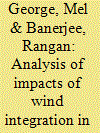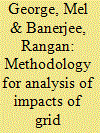| Srl | Item |
| 1 |
ID:
090105


|
|
|
|
|
| Publication |
2009.
|
| Summary/Abstract |
As the share of wind in power systems increases, it is important to assess the impact on the grid. This paper combines analysis of load and generation characteristics, generation adequacy and base and peak load variations to assess the future role of wind generation. A simulation of Tamil Nadu in India, with a high penetration of wind power (27% by installed capacity), shows a capacity credit of 22% of the installed wind capacity. For seasonal wind regimes like India, neither the capacity factor, nor the capacity credit reflects the monthly variation in the wind generation. A new approach based on the annual load duration curve has been proposed for generation expansion planning with higher penetration of wind. The potential savings in base and peak capacity required with increasing wind power have been quantified. A future scenario for Tamil Nadu for 2021 has been illustrated. It was found that 5500 MW of wind power can save 3200 MU of peak energy required or an average peak capacity of 2400 and 1100 MW of base capacity. This analysis would be useful to assess the future impacts of increasing wind capacity in grids.
|
|
|
|
|
|
|
|
|
|
|
|
|
|
|
|
| 2 |
ID:
103386


|
|
|
|
|
| Publication |
2011.
|
| Summary/Abstract |
Present electricity grids are predominantly thermal (coal, gas) and hydro based. Conventional power planning involves hydro-thermal scheduling and merit order dispatch. In the future, modern renewables (hydro, solar and biomass) are likely to have a significant share in the power sector. This paper presents a method to analyse the impacts of renewables in the electricity grid. A load duration curve based approach has been developed. Renewable energy sources have been treated as negative loads to obtain a modified load duration curve from which capacity savings in terms of base and peak load generation can be computed. The methodology is illustrated for solar, wind and biomass power for Tamil Nadu (a state in India). The trade-offs and interaction between renewable sources are analysed. The impacts on capacity savings by varying the wind regime have also been shown. Scenarios for 2021-22 have been constructed to illustrate the methodology proposed. This technique can be useful for power planners for an analysis of renewables in future electricity grids.
|
|
|
|
|
|
|
|
|
|
|
|
|
|
|
|